SCIENTIFIC NAME: Brassica oleracea
CULTURE: Kale prefers a fertile, well-drained soil high in organic matter with a pH range of 6.0-7.5. Consistent moisture will produce the best quality leaves. Direct Seed:Plant from early spring to approximately 3 months before expected autumn frost.
EARLY SPRING CROP: Use varieties suited to warm season production.
Early Transplants: Sow 2 seeds per cell in 50- to 72-cell plug flats, 3-4 seeds/2.5cm. in 20 row flats, or in outdoor beds 6mm deep. Seedlings should be ready to transplant in 4-6 weeks. If possible keep soil temperature over 24C until germination, then reduce air temperature to about 16C. Transplant outdoors 30-45cm apart in rows 45cm apart.
Early and later Paperpot Transplants; Use the 15cm chainpots and seed 2 plants to a cell. Prick out every second plant and every second cell, leaving a 30cm spacing, do three rows at 30 cm row spacing.
Kale prefers cooler growing temperatures, between 13-24C, optimum being 16-21C, but will produce good crops under warmer, summer conditions.
INTENSIVE SPACING: 12 rows, 6cm apart spaced every 4cm on the row 6-row seeder (C-M-T); Hole Size C, Middle pulleys,Tight brush setting | Jang JP-1 use F24 seed roller.
INTENSIVE HARVESTING: For optimum time efficiency use a Quick Cut Greens Harvester on baby leaf, always ensure a sharp blade is used.
TRANSPLANTS: Avg. 6,400 plants/30grams
SIZED SEEDS: Standard except where noted.
SEED SPECS: SEEDS/100g.: Avg.25,000.
AUTUMN CROP: Start seedlings as above in November and transplant to the garden in December-Jan. To ensure mature heads, seed the crop early in areas where heavy freezes occur early in autumn.
WINTER CROP: Successful kale crops can be grown where winters are mild (temperatures rarely below 0C). Transplants can be set out from April to August in these regions.
PESTS AND DISEASE: Kale is not as afflicted with pests as are other brassica crops, like cabbage. Apply row covers at the time of planting to exclude pests from the crop. Control cabbage worms and loopers with Bacillus thuringiensis (Bt.). Black rot and black leg can be seed-borne. We only stock seed lots that have been tested free of black rot in a sample of 30,000 seeds. Individual seed lots have been tested free of black leg in a sample of 1,000 seeds.
NOTE: A disease-free test result means that in the sample tested, the pathogen targeted was not found. It does not guarantee a seed lot to be disease-free. However, no method of seed treatment can positively ensure freedom from disease. We are glad to help with specific questions.
DAYS TO MATURITY: From direct seeding; subtract about 14 days if transplanting.
HARVEST: Large leaves. Beginning about 2 months after planting, harvest by clipping individual leaves. Kale is very hardy, and the eating quality will improve into the late autumn with light frost. Late summer sown or planted collards can be wintered in cold frames or hoophouses, or in the open in mild regions, to extend the season. Protecting with row covers can extend the harvest period.
AVG. DIRECT SEEDING RATE: For bunching: 1,000 seeds/75m row, 30g/330metres. For Intensive baby leaf: 1,000 seeds/3.3metres x 75 cm bed wilih or 30g/20 metres x 75 cm bed wilih.
Quick Facts
- Latin Name: Brassica oleracea
- Days To Maturity: 30 baby leaf
- Hybrid Status: Open Pollinated
- Product Features: Slow to bolt








